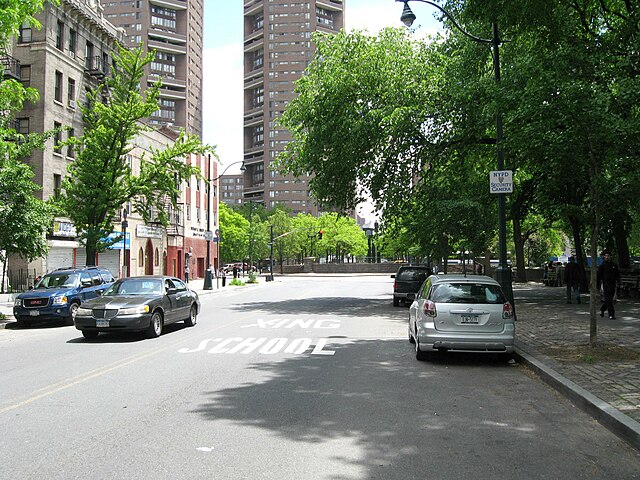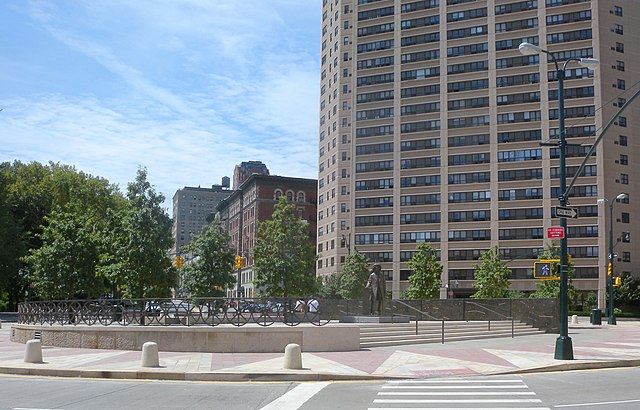Loading AI tools
West-east street in Manhattan, New York From Wikipedia, the free encyclopedia
110th Street is a street in the New York City borough of Manhattan. It is commonly known as the boundary between Harlem and Central Park, along which it is known as Central Park North. In the west, between Central Park West/Frederick Douglass Boulevard and Riverside Drive, it is co-signed as Cathedral Parkway.





110th Street is an eastbound street between First Avenue and Madison Avenue. The small portion between Madison Avenue and Fifth Avenue is westbound. West of Fifth Avenue, the road widens to accommodate two-way traffic.
The Duke Ellington Memorial, a statue of Duke Ellington, stands in Duke Ellington Circle, a shallow amphitheater at 110th Street and Fifth Avenue, at the northeast corner of Central Park. Unveiled in 1997, the statue, by sculptor Robert Graham, is 25 feet (7.6 m) tall, and depicts the Muses—nine nude caryatids—supporting a grand piano and Duke Ellington on their heads.[1] Duke Ellington Circle is also the site of the future Museum for African Art.
110th Street crosses Central Park West and Frederick Douglass Boulevard at the northwest corner of Central Park, Frederick Douglass Circle. West of there it is called Cathedral Parkway after the Cathedral of St. John the Divine.[2]
The Parkway forms the south edge of Morningside Park between Manhattan Avenue and Morningside Drive.[3] It forms the south edge of the Cathedral Close of St. John the Divine between Morningside Drive and Amsterdam Avenue, and ends at Riverside Drive before Riverside Park.
Central Park North is a section of West 110th Street. As the name implies, it lies at the northern end of Central Park. It is bounded by Central Park West on the west and Fifth Avenue on the east. It is notable for its incongruities; the Lincoln Correctional Facility—originally constructed in 1914 for the Young Women's Hebrew Association—stands a few blocks away from new luxury condo developments.
Central Park North has three of the original gates of Central Park. Farmers Gate is located at the southern end of Lenox Avenue/Malcolm X Boulevard, while Warriors Gate is located at the southern end of Seventh Avenue/Adam Clayton Powell Jr Boulevard. Pioneers Gate is at Fifth Avenue (Duke Ellington Circle).
The original Polo Grounds was located along Central Park North, between Fifth and Sixth avenues. Originally hosting polo, it was the home for the New York Metropolitans baseball club from 1880 to 1886 and for the New York Gothams—subsequently the Giants—from 1883 to 1888.
In the first decade of the 21st century, there was significant real estate development on properties with a view of Central Park. In 2003, Manhattan-based developer Athena headed by Louis Dubin bought a property on this street.[4][5] The building was pitched as "an opportunity for New Yorkers to be on the park at roughly half the price of Central Park South."[6] The rebirth of Harlem along Central Park north had attracted celebrities such as Marcia Gay Harden, Maya Angelou, and Kareem Abdul-Jabbar.[7] The finished building was 20 stories tall with 48 residential units, 9,500 of ground floor retail space, 48 parking spaces, and each unit had a view of Central Park.[8]
The elevated IRT Ninth Avenue Line used to reach a great height at its 110th Street station, before its demolition in 1940; it was infamous as a suicide location.[9][10] Today, there are four New York City Subway stations on 110th Street:
110th Street is served by the following New York City Bus routes, all heading west from Madison Avenue or east until Fifth Avenue:
Additional service is provided by the downtown M11, running east from Amsterdam to Columbus Avenues.[11]
The New York Central Railroad's 110th Street station previously existed on Park Avenue, which now carries the Park Avenue main line of the Metro-North Railroad. The station opened in 1876[12][13] and closed in 1906.[14]
West 110th Street is the southern boundary of the area where boro cabs may be hailed by passengers.[15]
George Gershwin lived in 501 West 110th Street, on the northwest corner of 110th and Amsterdam, where he composed his seminal piece Rhapsody in Blue.[16] Arthur Miller lived in 45 West 110th Street as a child.[17]
Seamless Wikipedia browsing. On steroids.
Every time you click a link to Wikipedia, Wiktionary or Wikiquote in your browser's search results, it will show the modern Wikiwand interface.
Wikiwand extension is a five stars, simple, with minimum permission required to keep your browsing private, safe and transparent.